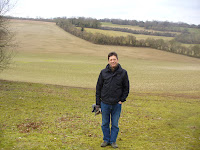
The Kent Downs round Hastingleigh with Andrew: March 6th 2010
I had to go back (by car) the other day to remind myself of this walk, and it was a perfect Autumn day with the heavily wooded Kent countryside glowing with deep reds and zinging gingers. When we did the walk back in March the trees were largely leafless, but we still had a clear sense of the way the current woodland reaches back to a time when wood drove the local economy. The walk took us past an ancient platt (?I feel as though that's the right word but just looked it up in OED and it's not there) of Kent cobtrees (there's been a revival of growing them more recently); through chestnut woods which at one time would have been systematically coppiced, but where the coppices had grown into great trees; and through newly managed coppices to feed the new green economy (much of the wood is sold as fuel for woodburning stoves).
We began the walk in Hastingleigh, a small village about 6 miles from Canterbury. Its name has an Anglo-Saxon derivation, but settlement here predates Anglo-Saxon times. The village is mentioned in the Domesday Book. We headed first down a green lane, opening on to a huge field, which we crossed towards Hastingleigh Church - now stranded some half a mile outside the village. The field was typical of the beautiful wide sweeps of agricultural land in this part of the Chalk Downs, littered with flints - the same flints used to build the Church, which is Saxon in origin. Two things linger in my memory - the plastic bags left in the porch to put over one's boots to keep the church floor clean, and the very beautiful 15th century rood screen. From the Church we struck up the line of the edge of the field, on an ancient pilgrims' path leading directly to Canterbury. We left this path to head across a couple of fields towards a rough wood. This field and the wood are apparently criss-crossed with badgers' setts; and n the wood are the ancient remains of cobtrees. From these we emerged on to a lane leading to another village, Bodsham - which happens to house a feted restaurant, Froggies (it's French...), but we weren't dressed for a stop there.
A particular point in the walk stands out for me: a moment when there is a break from one wooded area to another, which is like a break out into the land itself. A field spreads out beyond and outwards to our left as we pass from one clump of wood to the other, a characteristic sweep, not following an ordinary line, but somehow folding out in different planes and curves, almost joyous, but held too to the line of the chalk. We stop and look out, and take it in.

Then on to more woodland - and here the walk becomes a bit hazy to me, since it's over six months ago. Somewhere around here we got lost - a not uncommon event on my walks. But, in Andrew's inimitable words on another such occasion, 'It's not that we're lost; it's just that we don't know exactly where we are'. A good thing, amongst many, about going on a walk with Andrew - I know that we will eventually, and patiently, find our way. There was meant to be a signpost - a kingpost tree dating from long ago, a marker of boundaries, but somehow we missed it. Nonetheless we came out in time to the right path, through recently coppiced chestnut trees, passing a barrow - not much information on that except it was a barrow! and we were suitably impressed.
Though my memory of it may be imperfect, this was a lovely walk - very Kentish, with its chalk and flint fields, its flint buildings rising as if naturally from the land, its unhedged great agricultural sweeps and its closed coverts of trees very particular to this area. These trees - chestnut and cobnut and beech - were once food and fuel sources for life in much more straitened times, and they give an immediate link to those earlier times and lives. Of course, it will never be home, but I have been won over to the beauty of the Kent countryside - softer and less striking as it is compared with Yorkshire.
Suddenly we emerged from this deep countryside into the lane leading back to Hastingleigh - civilisation, albeit a quiet and hidden version. There is a pub, but I think we eschewed it. Thank you Andrew for a happy walk.
Next time: Norfolk with Mandy.
Lovely descriptions of the woodlands and the church, all sounding very historic and peaceful. I don't think somehow that Nick would have allowed you to pass by the pub had he been there - Thank you Sally and Andrew
ReplyDelete